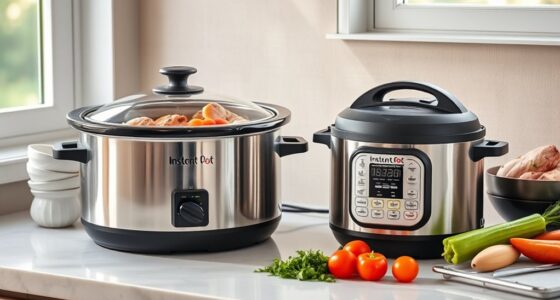Transform your leftovers into next day’s meals by thinking creatively. Repurpose roasted chicken into salads or wraps, turn rice into fried rice or stir-fries, and mash cooked vegetables into flavorful hashes or pancakes. Store leftovers properly in airtight containers labeled with dates for easy access and safety. Enhance flavors with herbs and sauces to keep meals appealing. Keep exploring tips and tricks to make your leftovers exciting and efficient—you’ll find plenty of ideas to try next.
Key Takeaways
- Analyze leftovers to identify versatile ingredients for new dishes like salads, stir-fries, or casseroles.
- Use simple flavor boosts such as herbs, spices, or sauces to refresh and enhance leftover meals.
- Store leftovers properly in labeled airtight containers for quick, safe access the next day.
- Plan ahead by cooking extra portions, enabling easy transformation into diverse, ready-to-eat meals.
- Get creative by blending, mashing, or layering leftovers to make appealing, time-saving meal options.

Have you ever wondered how to turn your leftovers into tasty, satisfying meals? “Leftover Magic” is all about transforming those extra ingredients into creative dishes that save time, reduce waste, and delight your taste buds. When it comes to meal repurposing, the key is thinking outside the box. Instead of simply reheating yesterday’s dinner, you can elevate those leftovers into entirely new meals that feel fresh and exciting. This approach not only minimizes food waste but also makes your meal prep more efficient.
Start by analyzing what you have. For example, if you have roasted chicken, consider shredding it to make a flavorful chicken salad or a hearty wrap. Leftover rice can become fried rice, a quick stir-fry, or even rice pudding for a sweet twist. Vegetables from last night’s roast can be tossed into a frittata or blended into a soup. The idea is to use leftovers as building blocks rather than final dishes. Creative leftovers don’t have to be complicated; sometimes a simple twist — adding fresh herbs, spices, or a different sauce — can turn an ordinary leftover into something extraordinary. Incorporating meal planning strategies can help you better organize your ingredients and reduce waste. Additionally, understanding how to properly store leftovers can prevent spoilage and ensure they remain safe to eat, which ties into the food safety principles essential for healthy eating.
Transform roasted chicken, rice, and vegetables into new dishes with simple twists and fresh ingredients.
Meal repurposing is also about convenience. Instead of letting leftovers sit in the fridge, plan to transform them into your next meal. For example, leftover pasta can be baked into a casserole with cheese and a crunchy topping, or turned into a cold pasta salad with fresh vegetables and vinaigrette. If you’ve got extra cooked vegetables, mash them into a veggie hash or blend into a savory pancake batter. These small adjustments make leftovers feel new and appealing, preventing mealtime monotony. Additionally, using proper storage techniques, such as airtight containers, helps keep leftovers fresh longer and makes leftover recycling more effective.
Another tip for creative leftovers is to prepare ahead of time. When you’re cooking, intentionally make extra portions or portion out leftovers into containers. Label them with the date and contents so you’re reminded to use them soon. This makes meal repurposing straightforward, as you already have ingredients ready to reimagine. Plus, it speeds up meal prep on busy days, letting you whip up something delicious without starting from scratch.
Additionally, keeping your leftovers in clearly labeled containers can help you easily identify which items are suitable for different gravel bike riding conditions, ensuring your kitchen remains organized and efficient. In the end, mastering meal repurposing means training yourself to see leftovers not as a chore but as an opportunity. With a little creativity, you can turn yesterday’s meal into a new culinary experience, saving money and reducing waste while satisfying your hunger. The magic of leftovers lies in your ability to transform, innovate, and enjoy every last bite of what you’ve already cooked.
Frequently Asked Questions
How Long Can Leftovers Be Safely Stored?
You might wonder how long leftovers are safe to eat. Food safety depends on proper storage techniques; typically, cooked leftovers stay good for 3 to 4 days in the refrigerator. Always store them in airtight containers and keep the temperature below 40°F. If in doubt, check for signs of spoilage like bad smell or mold. To avoid foodborne illnesses, follow these storage tips diligently.
What Are the Best Containers for Storing Leftovers?
You should choose the best containers for storing leftovers, focusing on airtight containers to keep food fresh and prevent spills. Opt for microwave-safe options so you can reheat leftovers directly without transferring to another dish. Look for containers made of glass or BPA-free plastic, as they’re durable and safe. These choices help preserve flavor, prevent contamination, and make reheating convenient, ensuring your leftovers stay delicious and safe to eat.
Can Leftovers Be Frozen for Future Use?
Imagine giving your leftovers a second chance at life. Yes, you can freeze them for future enjoyment! Use handy freezing tips like airtight containers or freezer bags, and label everything clearly. When you’re ready, guarantee safe thawing by transferring items to the fridge overnight or using a microwave’s defrost setting. This way, your leftovers stay fresh, tasty, and ready to serve whenever you crave them.
How Do I Reheat Leftovers Without Losing Flavor?
When reheating leftovers, you want to preserve flavor. Use microwave reheating on medium power to heat evenly, stirring or rotating food halfway through. Cover your dish to trap moisture and prevent drying out. You can also reheat on the stove over low heat, stirring often. These methods help keep the original flavors intact and assure your leftovers taste just as good the next day.
Are There Any Leftovers I Should Avoid Reusing?
You should avoid reusing leftovers that have spoiled or show signs of spoilage, like a sour smell or slimy texture, to guarantee food safety. Be cautious with cooked meats, seafood, and dairy, as they spoil quickly and can cause foodborne illnesses. To prevent spoilage, store leftovers promptly in airtight containers and consume them within a safe timeframe. This helps you enjoy leftovers safely and reduces waste.
Conclusion
So, next time you’re faced with leftovers, remember they’re more than just last night’s meal—they’re a chance to save time and reduce waste. Did you know that Americans throw away about 150,000 tons of food daily? By transforming leftovers into tasty next-day meals, you not only cut down on waste but also save money. Embrace leftover magic, and turn those extra bites into delicious, hassle-free dishes, making every meal count.









